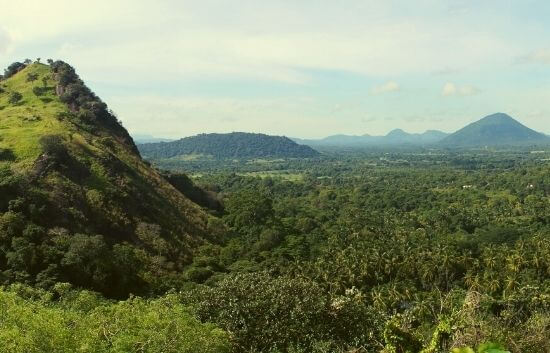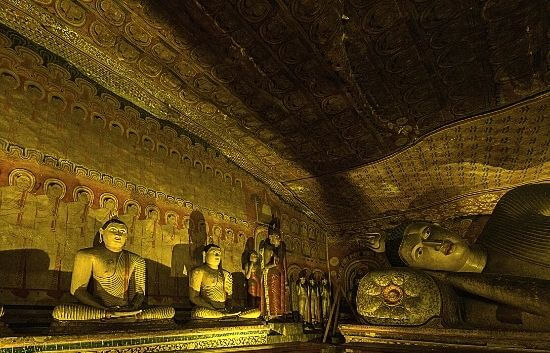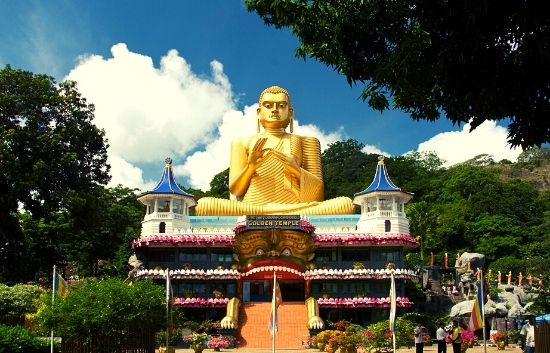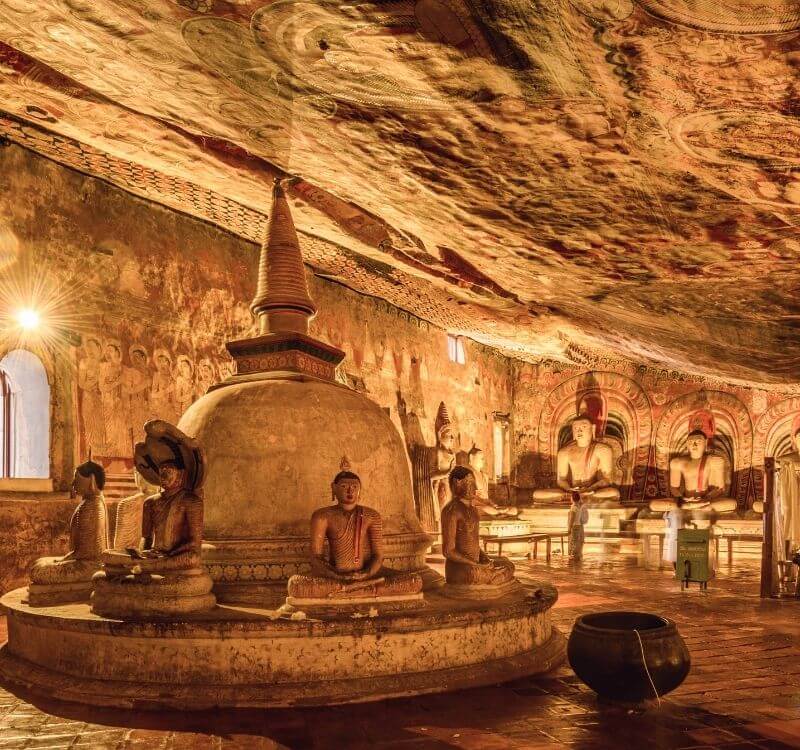Dambulla
Explore Dambulla with Our Comprehensive Travel Guide
Sitting almost at the heart of Sri Lanka’s Cultural Triangle, Dambulla is a bustling town famous for its incredible five cave temples that house over 150 exceptional works of art. The caves – a UNESCO World Heritage Site – reflect Sinhalese Buddhist art at its most impressive as each of the five caves are extravagantly decorated with intricate murals and statues.
History of Dambulla Cave Temples
The story of these cave temples date back to around 100BC. After just five months as king, Vattagamini Abhaya was forced into hiding by a group of Tamil invaders. He came across a deep rock overhang in Dambulla on an enormous granite outcrop and found refuge there for some 14 years before resuming his throne. In gratitude, Vattagamini partitioned the overhang into caves, and had temples built inside. Later kings, notably Nissankamalla (reigned 1187-96), and Kandyan kings Senerat (reigned 1604-35) and Kirti Sri Rajasinha (reigned 1747-82) embellished and remodelled the caves, and commissioned many of the murals that cover the walls.
Where is Dambulla?

Dambulla is located in the North Western Province of Sri Lanka, within Sri Lanka’s so-called Cultural Triangle. It is an important crossroads that intersects the Colombo–Trincomalee and Kandy–Anuradhapura roads, and is 156-kilometres from Sri Lanka’s capital, Colombo. The cave temples are located just outside town, up an enormous 160-metre-high rocky outcrop that enjoys spectacular panoramic views as far as Sigiriya, 15-kilometres distant.
What are the Dambulla Cave Temples?
Dambulla’s cave temples are a series of beautifully decorated and adorned caverns of varying sizes. Murals cover almost every inch of the undulating caverns, which are home to dozens of statues of the Buddha and his disciples, and of various kings involved in the site’s creation. The caves house some of the finest works of Buddhist art in Sri Lanka.
Cave 1
This cave, the Devalaya Viharaya (Temple of the Gods), is named after Vishnu whose images adorn the walls. Inside is an incredible 14-metre long sleeping Buddha carved out of the rock, and on his elbow can be seen traces of gold (though this is often covered). Other characters, such as the Buddha’s disciple Ananda are also depicted inside the cave.
Cave 2
The Maharaja Vihara (Temple of the Great Kings) is named after the two kings responsible for its creation – Vattagamini and Nissankalla. Both are depicted as statues. Quite aside from the cave’s impressive size (up to 50-metres long and 7-metres high) it is filled with many statues of the Buddha and Hindu gods, and adorned with impressive murals.
Cave 3
The Maha Aluth Viharaya (Great New Temple) is thought to be the handiwork of King Kirti Sri Rajasinha. Beneath a height of some 10-metres sit over 50 standing and seated Buddhas as well as one of the king himself, and two further Buddha statues – one meditating and the other sleeping – carved out of sheer rock. This cave is also equally impressive for the murals that adorn the walls and ceiling of the rock, and which date back to the 18th century.
Cave 4
The Paccima Viharaya (Western Cave) is one of the smallest caverns at Dambulla, although it is still packed with Buddha statues and there is a dagoba at the centre. Buddhas are also depicted in the wall murals alongside decorative chequered patterns and florals.
Cave 5
The smallest and newest cave, the Devana Aluth Viharaya (Second New Temple) features a 10-metre reclining Buddha and paintings of Vishnu, Kataragama and local deity, Bandara. Most statues in Dambulla are carved out of solid rock yet these are fashioned from brick and plaster.
Quick guide to Dambulla Cave Temples

•Do I need to buy tickets?
Yes. Purchase your tickets from the ticket office before you walk up to the caves.
•Are there any shops at the top?
No, there are no facilities (for food and drinks) once you leave the ticket office.
•What are the opening hours?
The site is open between 7am and 7pm, however the ticket office usually closes by 6pm.
•How long does it take to reach the top?
From the ticket office it’s a 15-minute’ walk to reach the caves via a series of steps.
•How long should I plan for a visit?
Most visits take 1-2 hours depending on how much time you’d like to spend in the caves.
•Which order should I visit the caves?
If you’d like to leave the best cave until last, visit the caves in reverse order, starting from Cave 5 and continuing towards Cave 2.
•Can I take photographs of the caves?
Yes. However it is prohibited to photograph a person with their back to a Buddha statue.
•What should I wear to visit Dambulla?
There is a modest dress code for visiting temples in Sri Lanka. Knees and shoulders must be covered.
•When’s the best time of day to visit Dambulla?
To avoid the heat, visit in the cooler hours of early morning and late afternoon. Sunsets can be magical from the summit of the rock.
Best time of year to visit Dambulla?

Dambulla’s cave temples can be visited throughout the year.
What else is there to see in/around Dambulla?
If you’re in town visiting Dambulla’s cave temples, don’t miss these tag-on sights:
•The Dambulla Museum receives a very low footfall yet is fascinating for its account of the development of Sri Lankan art from the very beginning through to the Kandyan era. Rooms exhibit copies of paintings from shrines and cave temples across Sri Lanka.
•Just 3-kilometres from Dambulla is the Popham Arboretum named after its creator, the British tea planter Sam Popham. Established in 1963, it’s 36-acre site preserves almost 300 trees and plants, including seven endemics. Wander the many trails independently or with a guide, starting from the park’s visitor centre. Book an evening guided walk and you may also see elusive local wildlife including loris, mouse deer and the rare pangolin.
•Particularly striking for its graceful presence, is the Aukana Buddha, a 40-minute drive from Dambulla. Reaching 12-metres high, the statue dates back to the eighth or ninth centuries and is unusual for being in the asisa mudra (blessing position). Aukana means ‘sun-eating’ so dawn, when light gently illuminates the statue, is the best time to visit.


